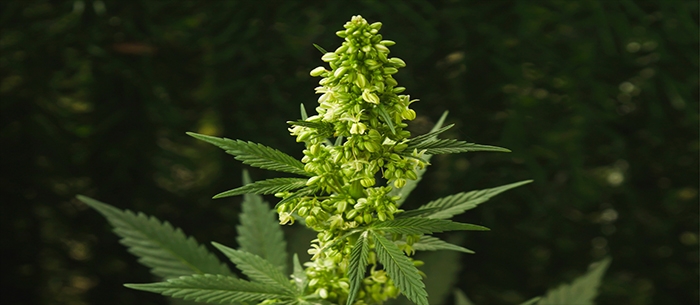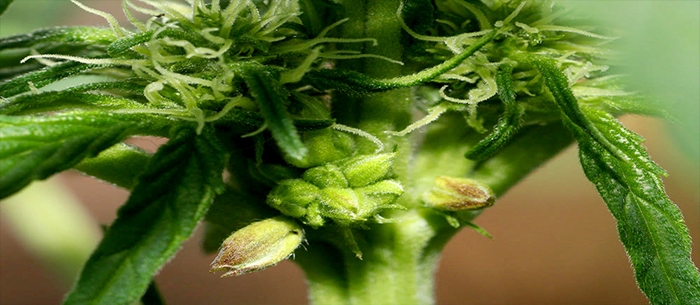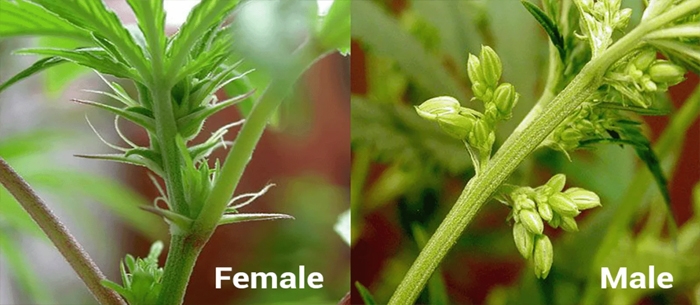Why the Gender of Cannabis Matters
Sinsemilla, also known as seedless flowers, is produced by the unfertilized female cannabis plants. During their maturation, such plants do not make seeds, focusing solely on forming dense buds rich in cannabinoids and terpenes. The fragrant and flavorful "ganja" comes only from female plants. That's why it's crucial to determine the gender of cannabis at the early stages of cultivation. As you probably guessed, there are only two genders – female and male, but sometimes, growers encounter hermaphrodite plants, combining qualities of both genders.
Female Cannabis Plants
Many ancient languages have different words for male and female hemp plants. The main distinction of female cannabis is the formation of female-type flowers, and its primary biological role is to produce new seeds for the natural continuation of the species.
Female plants develop elongated, conical, sizeable flowers. Each strain has a unique shape, texture, and density of buds, but more than anything they resemble conifer cones. When speaking of female flowers, we use the following terms:
Cola. It’s a stem covered in flowers. There can be two types:
- central cola, or main cola,
- secondary colas.
The central one is the largest. Side branches carry secondary colas, which are smaller in size.
Trichomes. Trichomes are cannabis glands that produce sticky and aromatic resin. Trichomes abundantly cover calyces, 'trim' leaves, and even fan leaves in some cases. The main task of trichomes is to protect cannabis from temperature fluctuations and pests. Their special value lies in their ability to synthesize resin rich in cannabinoids and terpenes.
Calyces and pistils. The calyces, inside which seeds mature if cannabis gets pollinated, are abundantly covered with trichomes that produce psychoactive substances. The shape and size of a calyx depend on the cannabis strain. Pistils grow from calyces, and their main function is to capture pollen from male plants. Pistils resemble long hairs, and initially, they are white. As the plants mature, they change color to yellow, orange, or even red. Sativa- and indica-type buds. Sativa and indica flowers differ in density and size, but their structure is the same. Sativa colas are large but relatively loose and form on long branches of tall, stretchy bushes. Sometimes, their stems cannot support the weight of flowers, requiring support. A characteristic feature of indica is the formation of smaller but quite dense buds. Indica bushes are compact and low-growing, and their buds can cover the entire plant stem.
Male Cannabis Plants

Male plants are responsible for keeping the vigor of the genetics. In the absence of diversity, the plant's protective function weakens, making it particularly susceptible to diseases, insect attacks, and pests.
The primary function of male cannabis plants is to pollinate female plants, which, in turn, are responsible for seed production. Offspring inherit 50% of their genetic code from each of their parents. Male plants pass on the following qualities to the seeds:
- the ability to thrive in a specific climate;
- growth rate;
- resistance to fungal diseases and mold;
- resistance to insect attacks. Breeders use low-growing male cannabis plants for pollination. Fast-growing and tall specimens are not suitable for this purpose. A good sign is the presence of large hollow stems – it signifies high THC levels.
Cannabis with Both Male and Female Characteristics

Plants of cannabis that simultaneously exhibit both male and female characteristics are called hermaphrodites. Discovering such plants in your garden is highly undesirable because they can potentially pollinate not only themselves but also nearby female plants. This leads to a decrease in yields.
In 80-90% of cases, hermaphrodites develop as female plants. They manifest their male characteristics closer to the middle of the growth cycle.
Usually, plants grown from regular cannabis seeds exhibit hermaphroditic traits. Sometimes, this risk also applies to feminized and autoflowering strains. Hermaphroditism is often found in cannabis with a broad set of sativa genetic traits. While it can occur in indica strains, it's relatively rare.
One of the primary reasons for the emergence of hermaphrodites is stress experienced by the plant under various circumstances. The main stressors include:
- critical fluctuations in daily temperature,
- nutrient overdosing or deficiency,
- excess or lack of moisture,
- unstable lighting conditions. Like male plants, hermaphrodites should be removed as soon as you detect them. Delaying this can result in the pollination of female plants. If your goal is to produce seeds, this might not be a problem, but if you want a good crop of buds, such "intruders" are not desirable. Getting rid of them should be done with extreme care to avoid the release of pollen sacks.
Key Differences Between Female and Male Plants

You can roughly determine the gender of cannabis plants around the fourth week of the vegetative stage. Pay attention to when the first calyces appear. In female plants, they form around the sixth week, while in male plants, calyces appear a bit earlier. The first calyces of both genders look like convex fist-like formations. The very first calyces are observed between the 4th and 6th nodes.
To determine the plant's gender, also take into account:
- Plant structure. Female plants are bushier and have more lateral branches. Male plants have longer internodes and less foilage.
- Plant height. Male plants are taller. In nature, this is necessary for them to dust female plants from above, covering as much area as possible.
- Flowers. Calyces of female buds have a pear-like shape with two long pistils for pollen capture. Male plant calyces typically group in sets of 5-6 and have a round shape. Over time, they turn yellow and become more elongated. It's crucial to determine the plant's gender early on. Otherwise, it becomes very challenging to obtain a yield consisting of unpollinated female buds. These female flowers contain a high level of THC, which is psychoactive. Experienced growers recommend isolating male plants as early as possible; otherwise, they will pollinate the females. In this case, the increase in THC-rich resin stops, and the plant redirects its energy towards seed production.
How to Increase the Number of Female Plants?
The simplest way to increase the number of female plants is to provide optimal growth conditions during the vegetative stage for 20-30 days.
Optimal daytime air temperature should be in the range of 19-26°C and should not drop below 18°C in the evening and at night. The optimal relative humidity range is 69-74%. For lighting in grow tents, lamps with a predominance of blue (cool) spectrum are more suitable during the vegetative stage, and lamps with a red (warm) or combined spectrum are preferred during the flowering stage.
![[``]](/wa-data/public/site/themes/kadama/img/kadama_logo.svg)




